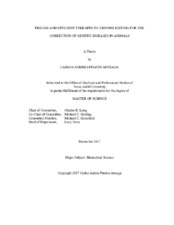| dc.description.abstract | There are more than 6,052 identified genetic mutations linked to disease in humans
and animals. Thanks to the advent of gene editing based on programmable nucleases and
the advances in DNA sequencing and writing technologies, it is now possible to make
precise changes in eukaryotic genomes with the potential to correct monogenic diseases,
from affected cells, tissues, organisms and eventually whole populations. This is the
concept behind therapeutic genome editing, which arises out of the idea that instead of
pursuing palliative care, the ideal therapy for monogenic diseases would be to develop a
method that can directly correct the disease-causing mutations.
Many of these disease alleles have been have been unknowingly co-selected when
performing phenotypic genetic selection on plants and animals. Although selected
breeding has been successful in the establishment and improvement of many different
strains of plants and breeds of animals, we have been propagating these disease alleles in
the populations. One of these deleterious alleles is the Glycogen Branching Enzyme
Deficiency (GBED), which is caused by a nonsense mutation (C > A) in the first exon of
the GBE1 gene that severely disrupts glycogen metabolism. This mutation is lethal in
homozygotes and an estimated 9% of Quarter Horse and Paint Horse lineages are
heterozygote carriers. In this work, we corrected this mutation in a heterozygous cell line derived from a high genetic merit American Quarter Horse stallion, by using CRISPRCas9.
The long-term goal is to use the corrected cell lines for somatic cell nuclear transfer
(SCNT) thereby generating a cloned animal that maintains the genetic merit of its
predecessor, but is free of the GBED mutation.
Precise genome editing requires the introduction of a double stranded break (DSB) at
an exact location in the genome and the correct DNA repair outcome. Although CRISPRCas9
has allowed for the introduction of precise DSBs in a very efficient manner, the lack
of control over cell-autonomous repair mechanisms namely non-homologous end-joining
(NHEJ) and homologous recombination (HR), is still the major bottle neck for seamless
genome editing. The DNA-dependent protein kinase (DNA-PK), composed of the Ku 70
- Ku 80 heterodimer and the DNA-PK catalytic subunit (DNA-PKvcs), is best known as the
NHEJ molecular sensor for DNA damage, but has been also identified as a pattern
recognition receptor (PRR) that defends against the invasion of foreign nucleic acids. Here
we devised a novel strategy that capitalizes on the natural ability of the Vaccinia virus
(VACV) C16 protein that evolved as an elegant subversion mechanism to inhibit the
detection of the VACV genome by the host cytoplasmic PRR defenses, specifically the
Ku-mediated DNA sensing. | en |


